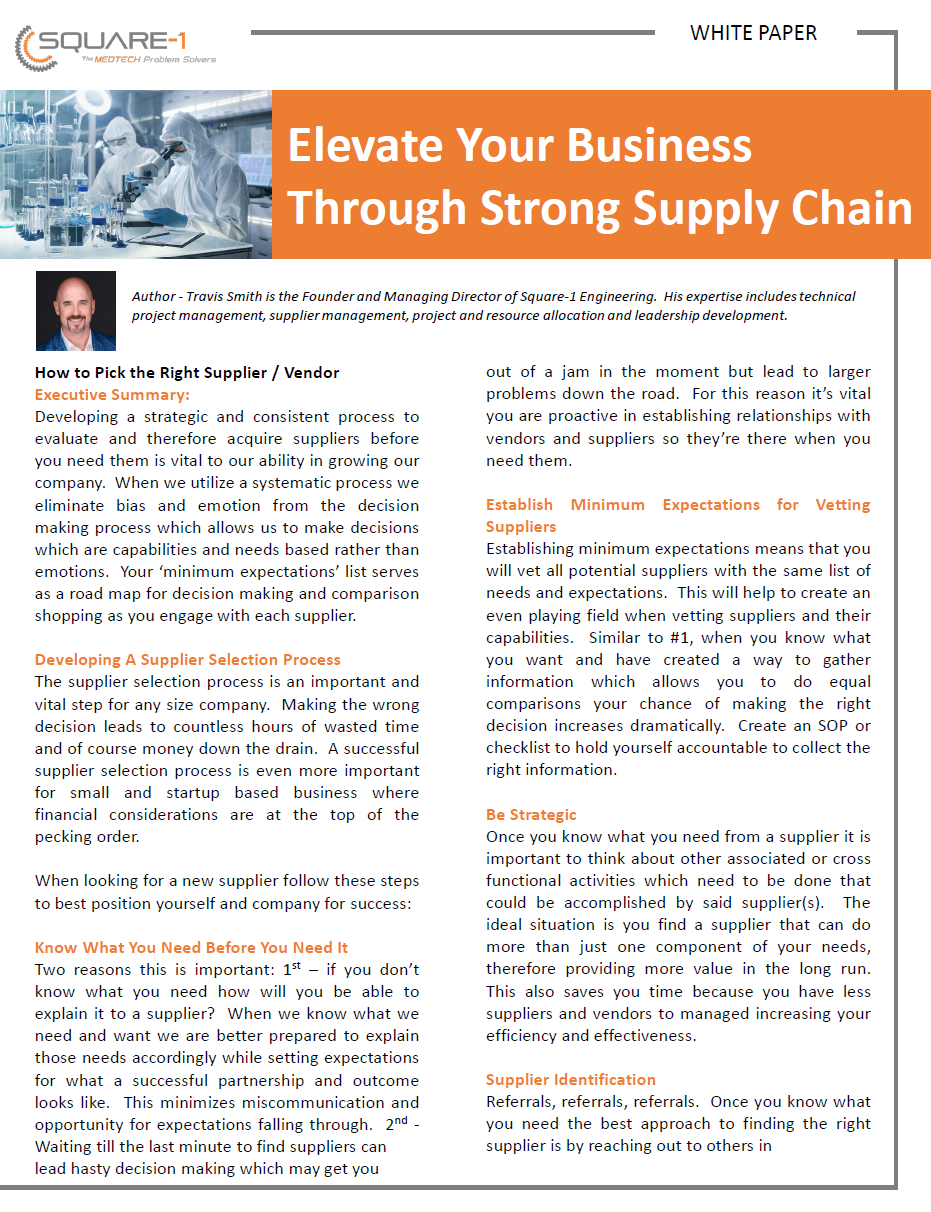|
Executive Summary
Developing a strategic and consistent process to evaluate and therefore acquire suppliers before you need them is vital to our ability in growing our respective companies. When we utilize a systematic process we eliminate bias and emotion from the decision making process which allows us to make decisions which are capabilities and needs based rather than emotions. Your ‘minimum expectations’ list serves as a road map for decision making and comparison shopping as you engage with each supplier. Developing A Supplier Selection Process The supplier selection process is an important and vital step for any size company. Making the wrong decision leads to countless hours of wasted time and of course money down the drain. A successful supplier selection process is even more important for small and startup based business where financial considerations are at the top of the pecking order. When looking for a new supplier follow these steps to best position yourself and company for success: Know What You Need Before You Need It Two reasons this is important: 1st – if you don’t know what you need how will you be able to explain it to a supplier? When we know what we need and want we are better prepared to explain those needs accordingly while setting expectations for what a successful partnership and outcome looks like. This minimizes miscommunication and opportunity for expectations falling through. 2nd - Waiting till the last minute to find suppliers can lead hasty decision making which may get you out of a jam in the moment but lead to larger problems down the road. For this reason it’s vital you are proactive in establishing relationships with vendors and suppliers so they’re there when you need them. Establish Minimum Expectations for Vetting Suppliers Establishing minimum expectations means that you will vet all potential suppliers with the same list of needs and expectations. This will help to create an even playing field when vetting suppliers and their capabilities. Similar to #1, when you know what you want and have created a way to gather information which allows you to do equal comparisons your chance of making the right decision increases dramatically. Create an SOP or checklist to hold yourself accountable to collect the right information. Be Strategic Once you know what you need from a supplier it is important to think about other associated or cross functional activities which need to be done that could be accomplished by said supplier(s). The ideal situation is you find a supplier that can do more than just one component of your needs, therefore providing more value in the long run. This also saves you time because you have less suppliers and vendors to managed increasing your efficiency and effectiveness. Supplier Identification Referrals, referrals, referrals. Once you know what you need the best approach to finding the right supplier is by reaching out to others in your industry, or industry associations, to learn who they use, and just as important who they don’t use. Take the time to read reviews, gather intel from people you trust before you start calling potential suppliers. While sites like Thomas.net and Google can provide this information, it is likely you will quickly find yourself overwhelmed with information. In the end the most useful data is those which are unbiased or comes from experience -this is best collected from a trusted resource. Outreach and Selection When speaking for the first time with a potential new supplier try to connect with the people you will actually be working with, not just the company’s sales person. This is important because once the relationship is established the majority of your time won’t be spent with their sales people rather those delivering the service or product. What is their communication like? Do they respond quickly and address mistakes immediately? What is their customer retention rate? Find out how long their employees have been with the company too. If the company suffers from consistent turnover that should be a big red flag as you will likely have to be much more involved with this supplier helping coach and direct new employees to ensure the work is done properly. Also, where are you in the pecking order of the level of importance to the supplier? Don’t be fooled not all clients are treated equal, even if they tell you otherwise. When you know where you stand it is easier to build a relationship based on realistic expectations. In the end, supplier selection should come down to three things, in ranked order: 1. Performance 2. Relationship 3. Price Key Takeaway At the end of the day it doesn’t matter how affordable or cost effective a supplier is, or how nice they are as people. If they can’t perform, and do so consistently, the other two don’t matter. I’ve also found that paying a bit more for the right service and relationship often times is worth the investment it in the long run. #whitepaper #supplychain #supplier #vendor #selectionprocess #outsource #square1engineering #medtech #medicaldevice
0 Comments
Opening Salvo: Consulting, it’s the next big business opportunity frontier. From 2011 to present the consulting industry grew by 4-5% YOY on the coattails of increasing supply and demand. More people than ever on record have transitioned out of traditional career roles in the last 15 years to chase the ‘gig economy’ (increasing supply) while companies themselves have developed a steady dependency (increasing demand) on using external support to ensure their operations run effectively and efficiently. While this sounds encouraging, an unexpected outcome of this growth has left many customers with buyers remorse. As more people enter the consulting game the varying levels of experience, service, costs and related outcomes has left customers in a predicament. With a multitude of options now available to companies looking for help one of the biggest challenges afflicting buyers is how they will find the right support while ensuring the money they’re paying for it results in a positive outcome. Author: Travis Smith To view the full article click on the download link below:
Executive Summary: Businesses of all sizes must make strategic decisions to ensure its operations and outputs are optimized, functioning at an effective level to help them grow, increase speed to market, improve ROI, etc. One tool which helps to achieve those metrics, and more, is outsourcing. For the purposes of this paper we’re define ‘outsourcing’ as the act of packaging internal work to be sent outside to an external supplier to facilitate on behalf of the company, now client. There are many positive attributes of outsourcing, yet there are a bevy of deltas which accompany outsourcing if the client doesn’t carefully vet and manage their suppliers. Outsourcing, a valuable strategic business tool, is best experienced where expectations are managed while relationships are allowed to develop overtime. This produces fruitful outcomes for both client and supplier. Author: Travis Smith Contributor(s): Bill Colone, Achilles Young To view the full article click on the download link below:
Executive Summary: Developing a strategic and consistent process to evaluate and therefore acquire suppliers before you need them is vital to our ability in growing our company. When we utilize a systematic process we eliminate bias and emotion from the decision making process which allows us to make decisions which are capabilities and needs based rather than emotions. Your ‘minimum expectations’ list serves as a road map for decision making and comparison shopping as you engage with each supplier. Author: Travis Smith Read the full article by downloading the below PDF attachment
Executive Summary: The world of startups and small business can indeed be an exciting place to be. Its commonly characterized as highly collaborative, fast pace, less bureaucratic and wildly innovative. While this sounds great in theory, in practice the world of a startup can be rife with challenge, including heavy amounts of stress and uncertainty. It’s vital we as professionals analyze our personalities and professional behaviors to assess whether or not we would do well in the startup world - before we actually jump in. Knowing what you’re up against before you dive in will allow you to determine if it’s appropriate for you to consider the startup space, small business and or entrepreneurship. Author: Travis Smith Read the full article by downloading the below PDF attachment
Executive Summary: If your company lacks a ‘gold standard’ for its product design practices you are inevitably wasting time, resources and funds. Implementing and running a gold standards program is essential to operating at peak performance. Start by developing a best in practice plan. From there setup a review plan to provide feedback on all work performed. Once the infrastructure of your new gold standard system is established you’ll want to assess the skills of your team and develop a training program which can be offered to both new and existing employees. Author(s): Travis Smith & Tim Humphrey Read the full article by downloading the below PDF attachment
About the AuthorTravis Smith is the founder and managing director of Square-1 Engineering, a medical device consulting firm, providing end to end engineering and compliance services. He successfully served the life sciences marketplace in SoCal for over 15 years and has been recognized as a ‘40 Under 40’ honoree by the Greater Irvine Chamber of Commerce as a top leader in Orange County, CA. Categories
All
Archives
April 2024
|
||||||||||||||||||||||||||||||
Visit Square-1's
|
|







 RSS Feed
RSS Feed


